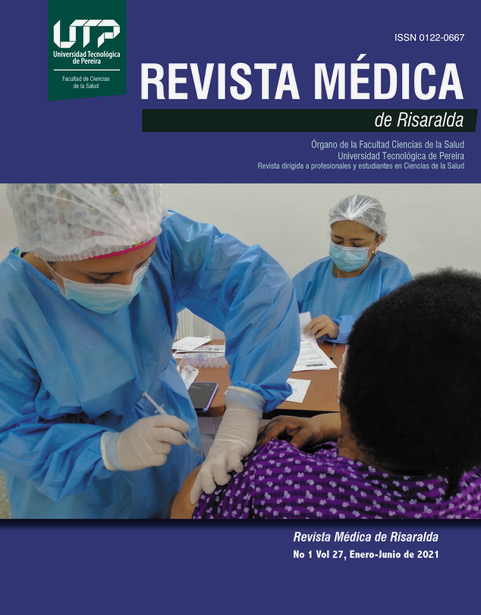DRESS síndrome (Drug Reaction with Eosinophilia and Systemic Symptoms) associated with Tubulo Interstitial Nephritis in a adolescent
DOI:
https://doi.org/10.22517/25395203.24661Keywords:
DRESS Syndrome, Eosinophilia, Renal insufficiency, Nephritis interstitial, PediatricAbstract
DRESS syndrome (Drug Reaction with Eosinophilia and Systemic Symptoms) is a rare pathology in Pediatrics, first described in 1996 by Bocquet. It can appear in a variable period of time after exposure to some medications, it is characterized by fever, skin involvement and internal organs. A 13-year-old patient is presented, with a history of use of Trimethoprim sulfa for two months, with a disease of three days of evolution, consisting of fever and skin rash, without mucosal involvement, with an unfavorable response to steroid management, requiring Intravenous inmunoglobulin. Weeks after the onset of symptoms and stable evolution, he presented acute renal failure that required renal replacement therapy. Other underlying autoimmune pathologies were ruled out. There was recovery of renal function test and normalization of the other paraclinical on day 40 of the disease. Patient remains asymptomatic four months later, with oral steroid treatment, in slow and gradual decline. Permanent evaluation of renal function tests should be considered in patients with DRESS syndrome, due to its association with acute tubulointerstitial nephritis and related complications.
Downloads
References
Karakayali B, Yazar AS, Çakir D, Cetemen A, Kariminikoo M, Deliloglu B, et al. Drug Reaction with Eosinophilia and Systemic Symptoms (DRESS) syndrome associated with cefotaxime and clindamycin use in a 6 year-old boy: a case report. Pan Afr Med J [Internet] 2017; 28:1–5. https://10.11604/pamj.2017.28.218.10828.
Shiohara T, Mizukawa Y. Drug-induced hypersensitivity syndrome (DiHS)/drug reaction with eosinophilia and systemic symptoms (DRESS): An update in 2019. Allergol Int [Internet] 2019; 68(3):301–8. https://10.1016/j.alit.2019.03.006
Mori F, Caffarelli C, Caimmi S, Bottau P, Liotti L, Franceschini F, et al. Drug reaction with eosinophilia and systemic symptoms (DRESS) in children. Acta Biomed 2019; 90(8):66–79. https://10.23750/abm.v90i3-S.8167
Criado PR, Criado RFJ, Avancini JM SC. Drug Reaction with Eosinophilia and Systemic Symptoms (DRESS) / Drug-induced Hypersensitivity Syndrome (DIHS): A review of current concepts. An Bras Dermatol 2012; 87(3). p. 435–49.
Metterle L, Hatch L, Seminario‐Vidal L. Pediatric drug reaction with eosinophilia and systemic symptoms: A systematic review of the literature. Pediatr Dermatol [Internet] 2020 Jan 5; 37(1):124–9. https://10.1111/pde.14044
Watanabe H. Recent Advances in Drug-Induced Hypersensitivity Syndrome/Drug Reaction with Eosinophilia and Systemic Symptoms. J Immunol Res [Internet] 2018; 2018:1–10. https://10.1155/2018/5163129
Nguyen M, Chen Y, Tartar D. Characteristics of patients hospitalized for drug reaction with eosinophilia and systemic symptoms (DRESS) at a level 1 trauma center. J Invest Dermatol [Internet] 2019 Sep; 139(9):B13. Available from: https://linkinghub.elsevier.com/retrieve/pii/S0022202X19316926
Del Olmo-Gil E, Galindo-López MP, Maya-Gutiérrez A, Maya-Granados N, Barragán-Martínez JA, Alexanderson-Rosas G, et al. Síndrome de DRESS. Presentación de 2 casos y revisión de la literatura [Internet] Vol. 77, Rev Med Hosp Gen Méx. 2014. Available from: www.elsevier.es/
Silva-Feistner M, Ortiz E, Rojas-Lechuga MJ, Muñoz D. Síndrome de sensibilidad a fármacos con eosinofilia y síntomas sistémicos en pediatría. Caso clínico. Rev Chil Pediatr. 2017; 88(1):164–8. https://10.1016/j.rchipe.2016.05.010
Cabañas R, Ramírez E, Sendagorta E, Alamar R, Barranco R, Blanca-López N, et al. Spanish guidelines for diagnosis, management, treatment, and prevention of dress syndrome. J Investig Allergol Clin Immunol. 2020; 30(4):229–53.
Tomani M, Caridi C, Charlot C. Complicated Drug Reaction with Eosinophilia and Systemic Symptoms ( DRESS ) Syndrome History in a 14-Year-Old. Am J Case Rep 2021; 22: 1–7. https://10.12659/AJCR.927951
Shanoj K, Joseph S, Shenoy P. Drug reaction with eosinophilia and systemic symptoms syndrome. Indian J Rheumatol. 2019; S59-66. https://10.4103/0973-3698.272151
Fernández-Reyes MM, Ramírez-Rosales A, Guerrero-Izaguirre I, López-Romo A. DRESS syndrome. Dermatologia Rev Mex. 2018; 62(6):522–8.
Kardaun SH, Mockenhaupt M, Roujeau JC. Comments on: DRESS syndrome. J Am Acad Dermatol [Internet] 2014; 71(5):1000-1000.e2. https://10.1016/j.jaad.2013.11.053
Nieto-Ríos JF, Ruiz-Velásquez LM, Álvarez L, Serna-Higuita LM. Nefritis tubulointersticial aguda. Revisión bibliográfica. Iatreia. 2020; 33(2):155–66. https://10.17533/udea.iatreia.45
Ruebner RL, Fadrowski JJ. Tubulointerstitial Nephritis. Pediatr Clin North Am [Internet] 2019; 66(1):111–9. https://10.1016/j.pcl.2018.08.009
Higashi Y, Baba N, Yoshimine H, Sakaguchi I, Kanekura T. Late-onset interstitial nephritis in a patient with drug-induced hypersensitivity syndrome/drug reaction with eosinophilia and systemic symptoms. J Dermatol. 2020;47(2):174–7. https://10.1111/1346-8138.15175
Downloads
-
Vistas(Views): 395
- PDF (Español (España)) Descargas(Downloads): 282
- PDF Descargas(Downloads): 181
Published
How to Cite
Issue
Section
License
Cesión de derechos y tratamiento de datos
La aceptación de un artículo para su publicación en la Revista Médica de Risaralda implica la cesión de los derechos de impresión y reproducción, por cualquier forma y medio, del autor a favor de Facultad de Ciencias de la Salud de la Universidad Tecnológica de Pereira. 1995-2018. Todos los derechos reservados ®
por parte de los autores para obtener el permiso de reproducción de sus contribuciones. La reproducción total o parcial de los trabajos aparecidos en la Revista Médica de Risaralda, debe hacerse citando la procedencia, en caso contrario, se viola los derechos reservados.
Asimismo, se entiende que los conceptos y opiniones expresados en cada trabajo son de la exclusiva responsabilidad del autor, sin responsabilizarse ni solidarizarse, necesariamente, ni la redacción, ni la editorial.
Es responsabilidad de los autores poder proporcionar a los lectores interesados copias de los datos en bruto, manuales de procedimiento, puntuaciones y, en general, material experimental relevante.
Asimismo, la Dirección de la revista garantiza el adecuado tratamiento de los datos de carácter personal



